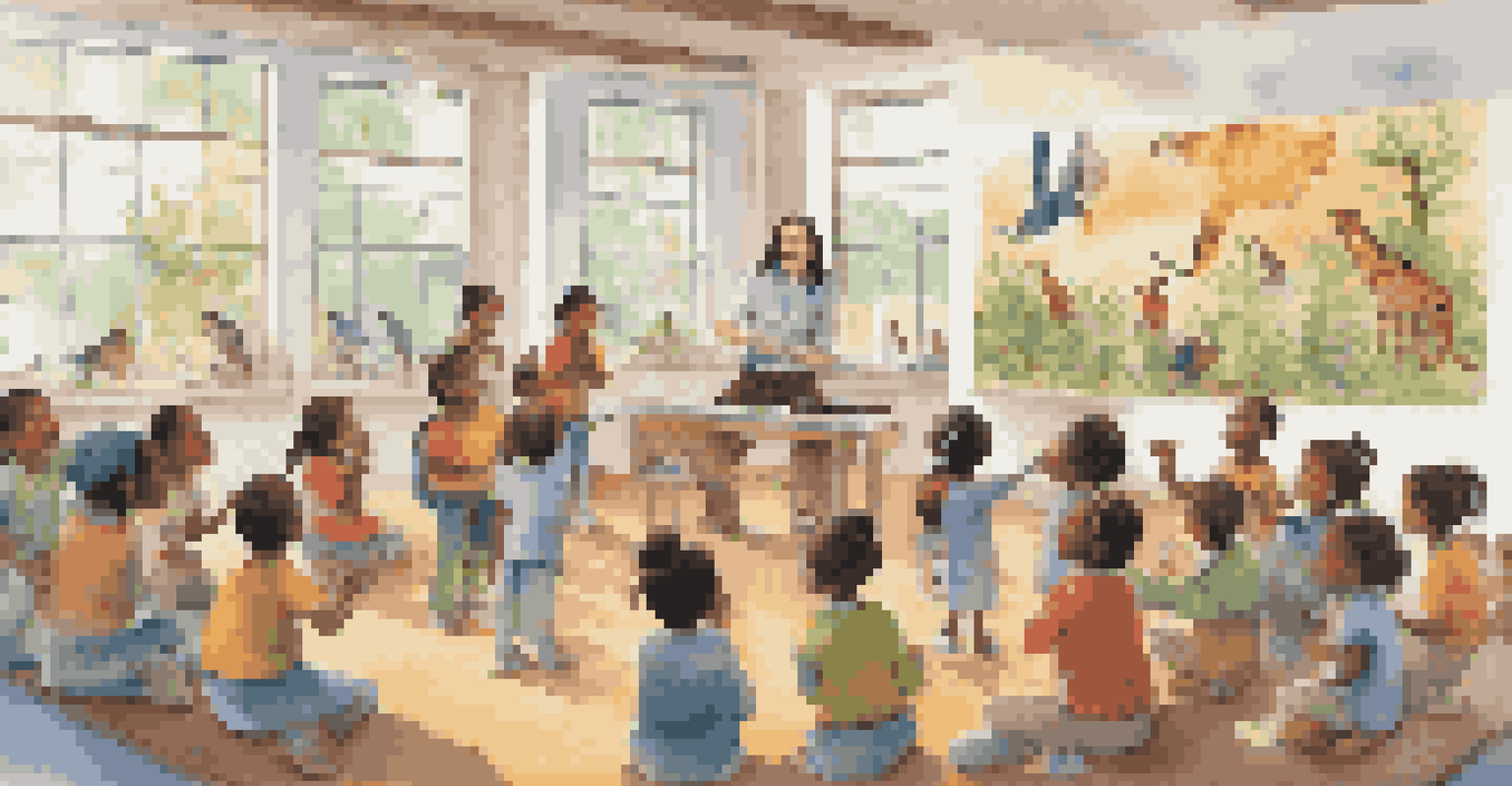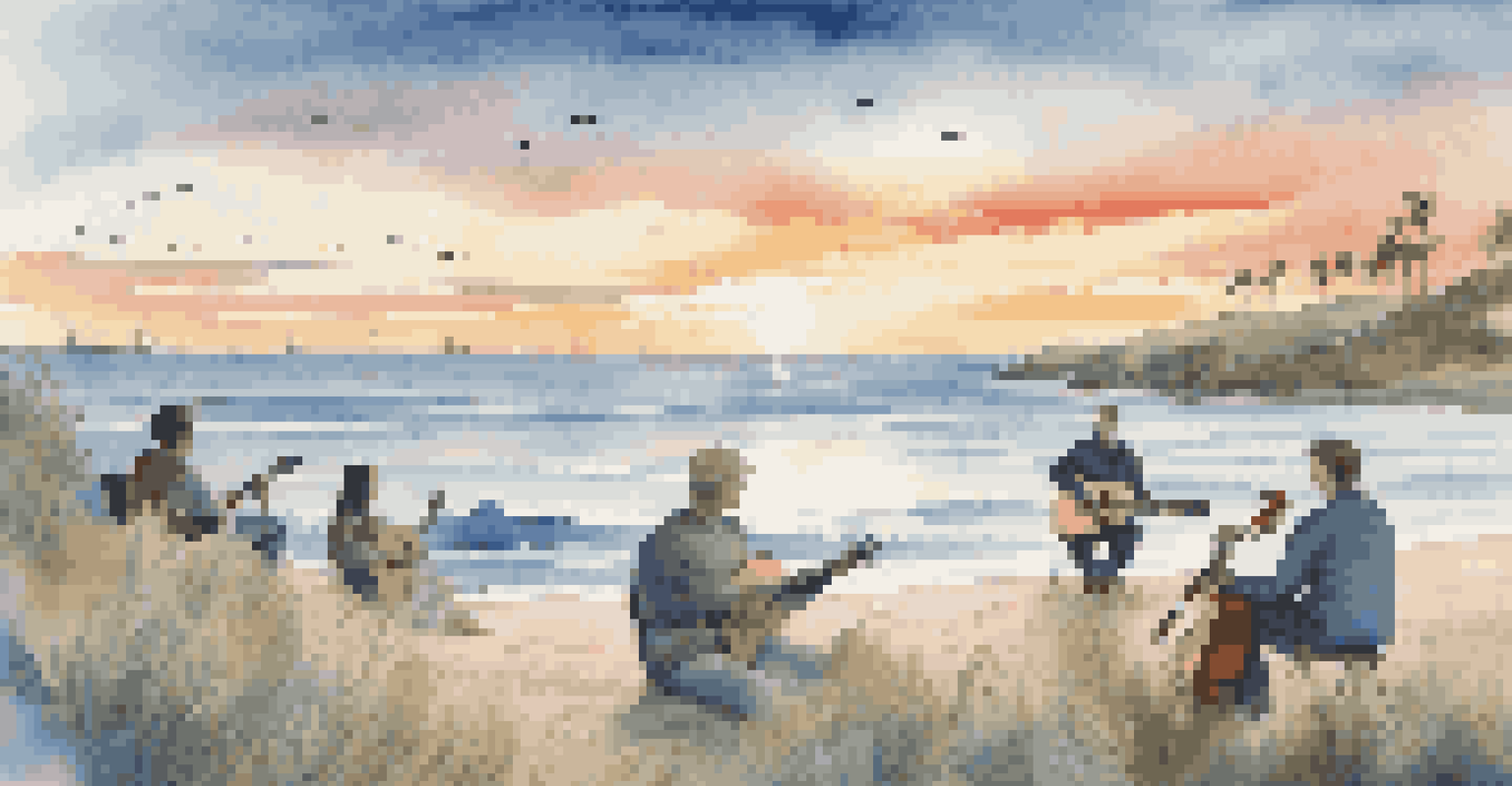Using Music to Drive Awareness for Biodiversity Conservation

The Connection Between Music and Nature Conservation
Music has always been a powerful medium for expression, but it also serves as a bridge to connect people with nature. When melodies evoke the sounds of the wild, they can remind us of the beauty and fragility of ecosystems. This connection can inspire individuals to take action in their own communities, fostering a deeper appreciation for biodiversity.
Music can change the world because it can change people.
Think about the songs that celebrate nature—like 'Blackbird' by The Beatles or 'Big Yellow Taxi' by Joni Mitchell. These tunes not only entertain but also educate listeners about environmental issues. By incorporating nature themes, musicians can raise awareness and encourage their fans to think critically about the world around them.
Furthermore, music festivals often promote conservation efforts, showcasing how the arts can support ecological causes. When attendees hear about the impact of their actions while enjoying live performances, they’re more likely to engage with conservation initiatives, making music a valuable ally in the fight for biodiversity.
Case Studies: Successful Music Campaigns for Conservation
Several campaigns have creatively harnessed music to promote biodiversity. One notable example is the 'Songs for the Sea' initiative, which uses music to draw attention to ocean conservation. Artists from various genres contribute songs that highlight the importance of marine ecosystems, encouraging listeners to take action.

Another inspiring case is the 'Earth Day Live' concert, which features artists advocating for climate action. By combining powerful performances with urgent messages, these events mobilize audiences to support environmental policies that protect biodiversity. The energy of live music can transform awareness into action, making a tangible difference.
Music Inspires Nature Conservation
Songs and melodies can evoke emotions that connect listeners to environmental issues, motivating them to support biodiversity efforts.
These campaigns show that music is not just entertainment; it can serve as a catalyst for change. When artists use their platforms to promote conservation, they create a ripple effect that resonates with fans and encourages a collective commitment to protecting our planet.
The Role of Music in Education and Awareness Programs
Music can be a fantastic tool in educational programs aimed at raising biodiversity awareness. By integrating songs and rhythms, educators can engage students in a fun and memorable way. This approach allows complex topics, like ecosystem dynamics, to be more digestible and relatable for young learners.
The earth has music for those who listen.
For instance, using catchy jingles about endangered species can help kids remember important facts and inspire them to care about wildlife. These musical elements can turn a standard lesson into an interactive experience, making learning about biodiversity exciting.
Moreover, music workshops can encourage creative expression while instilling environmental values. Participants can write their own songs about local wildlife, fostering a personal connection to their surroundings and emphasizing the importance of preserving biodiversity.
Community Engagement Through Music Events
Community events that incorporate music can significantly boost local conservation efforts. These gatherings create a festive atmosphere where people come together to celebrate and learn about biodiversity. By blending entertainment with education, communities can foster a sense of belonging and shared responsibility for the environment.
For example, local concerts can feature talks from conservationists alongside musical performances. This setup not only entertains but also informs attendees about local wildlife and conservation issues. Engaging the community in this way helps to cultivate a culture of environmental stewardship.
Successful Campaigns Use Music
Creative music campaigns, like 'Songs for the Sea', effectively raise awareness and mobilize audiences for conservation initiatives.
Additionally, music events can raise funds for conservation initiatives, providing essential resources for local projects. When people enjoy themselves and feel a personal connection to the cause, they’re more likely to contribute to the movement and support biodiversity efforts.
The Power of Lyrics in Promoting Environmental Messages
Lyrics have the unique ability to convey powerful messages and stories, making them a potent tool for promoting biodiversity. When artists craft lyrics that reflect environmental themes, they can resonate deeply with listeners, sparking curiosity and concern for the planet. Songs that tell stories about endangered species or the effects of climate change can leave a lasting impact.
For instance, songs like 'Mercy Mercy Me (The Ecology)' by Marvin Gaye highlight the struggles of the environment while evoking emotional responses. These narratives can inspire listeners to reflect on their own relationship with nature, motivating them to take steps towards conservation.
The beauty of music lies in its ability to reach diverse audiences, transcending language and cultural barriers. When artists use their craft to speak about biodiversity, they can connect with people from all walks of life, creating a united front for environmental protection.
Collaborations Between Musicians and Conservation Organizations
Collaborations between musicians and conservation organizations can amplify the impact of both parties. These partnerships allow artists to leverage their influence while supporting important environmental causes. By working together, they can create campaigns that raise awareness and funds for biodiversity conservation.
An example of this collaboration is the partnership between the Wildlife Conservation Society and various artists who donate a portion of their concert proceeds to support wildlife protection. These efforts highlight the shared responsibility of protecting our natural world and encourage fans to get involved.
Education Through Musical Engagement
Integrating music into educational programs makes learning about biodiversity enjoyable and memorable for students.
Such collaborations not only benefit the environment but also enhance the musicians’ engagement with their audience. Fans appreciate when artists take a stand on important issues, fostering a sense of loyalty and community among supporters of both the artist and the cause.
The Future of Music in Biodiversity Conservation Efforts
Looking ahead, the role of music in biodiversity conservation is likely to grow even more significant. As environmental issues become more pressing, musicians have the opportunity to use their platforms to drive awareness and change. With the rise of digital streaming, the reach of music is broader than ever, allowing artists to connect with global audiences.
Innovations in technology, such as virtual concerts and interactive music apps, can further enhance engagement. These platforms can include educational components that inform listeners about biodiversity while providing an entertaining experience. The blending of technology and music can create unique opportunities for conservation storytelling.

As we move forward, it is essential for artists, organizations, and communities to collaborate and harness the power of music. Together, they can inspire action and cultivate a deeper commitment to protecting the planet, ensuring that future generations inherit a rich and diverse ecological landscape.